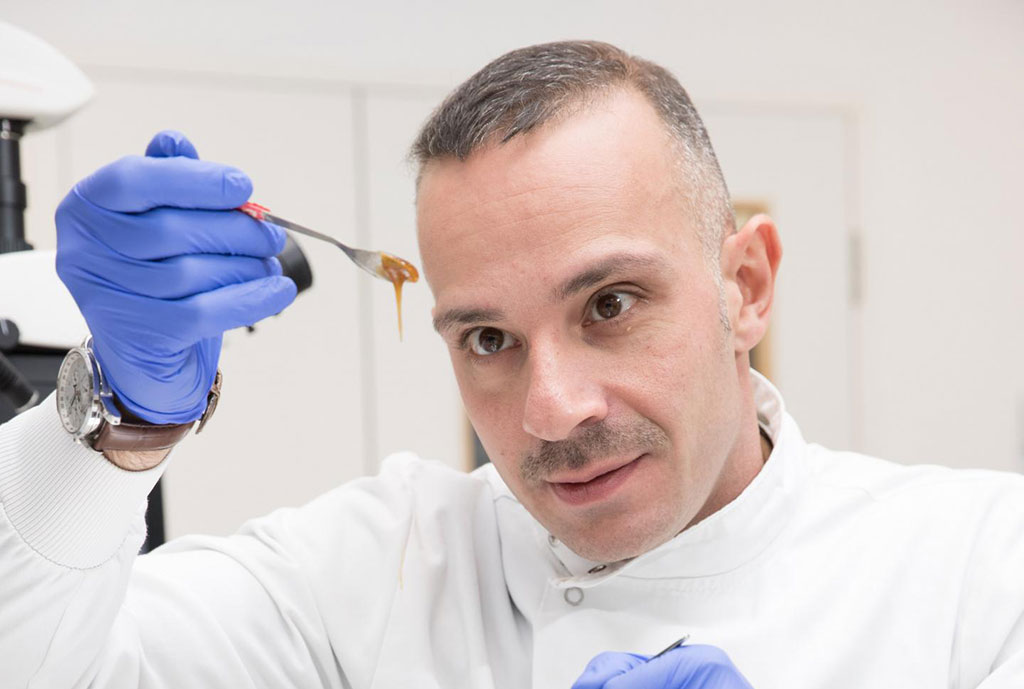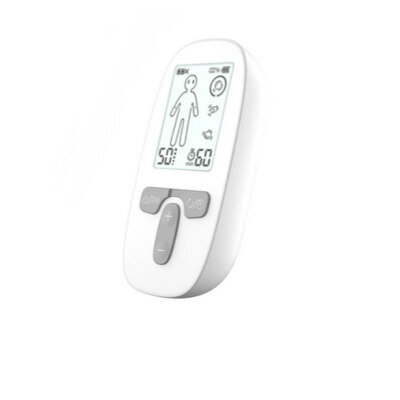Surgical Meshes Impregnated with Manuka Honey Fight Infections
|
By HospiMedica International staff writers Posted on 17 Dec 2019 |

Image: Dr. Piergorgio Gentile and Manuka honey (Photo courtesy of Newcastle University)
Sandwiching tiny amounts of Manuka honey between surgical mesh layers can provide protection against bacterial infection for up to three weeks, according to a new study.
Developed by researchers at Ulster University (Newtownabbey, United Kingdom), the University of Leeds (United Kingdom), Newcastle University (United Kingdom), and other institutions, the surgical mesh was created via layer-by-layer (LBL) nanotechnology assembly by sandwiching eight layers each of negatively charged Manuka honey nanolayers and a positively charged biomimetic electrospun poly(ε-caprolactone) polymer. Each layer was just 10-20 nm in thickness.
Different cell lines, including human immortalized and primary skin fibroblasts, and primary endothelial cells, were exposed to the mesh to confirm membrane cytocompatibility. The Manuka honey meshes were then exposed to various Gram-negative and Gram-positive bacteria responsible for infections in the body, such as Staphylococcus, methicillin-resistant Staphylococcus aureus (MRSA), and E. coli. The results showed that antimicrobial MH activity was dependent on the concentration used, and the strains tested. The study was published on December 4, 2109, in Frontiers in Bioengineering and Biotechnology.
“Honey has been used to treat infected wounds for thousands of years, but this is the first time it has been shown to be effective at fighting infection in cells from inside the body,” said senior author Piergorgio Gentile, PhD, of Newcastle University. “Similarly layered antibiotic-releasing coatings to protect implants against bacterial infection have been judged as failing to provide durable protection, as it could encourage the development of drug resistant bacterial strains.”
Manuka (Leptospermum) honey is made from the tree species Leptospermum, found in New Zealand and Australia. The antibacterial effect of Manuka honey is due to the presence of methylglyoxal (MGO), which forms from the compound dihydroxyacetone (DHA) present in nectar, and converted into MGO during the ripening of honey. The level of MGO in Manuka honey is 100 or more times higher than in other types of honey.
Related Links:
Ulster University
University of Leeds
Newcastle University
Developed by researchers at Ulster University (Newtownabbey, United Kingdom), the University of Leeds (United Kingdom), Newcastle University (United Kingdom), and other institutions, the surgical mesh was created via layer-by-layer (LBL) nanotechnology assembly by sandwiching eight layers each of negatively charged Manuka honey nanolayers and a positively charged biomimetic electrospun poly(ε-caprolactone) polymer. Each layer was just 10-20 nm in thickness.
Different cell lines, including human immortalized and primary skin fibroblasts, and primary endothelial cells, were exposed to the mesh to confirm membrane cytocompatibility. The Manuka honey meshes were then exposed to various Gram-negative and Gram-positive bacteria responsible for infections in the body, such as Staphylococcus, methicillin-resistant Staphylococcus aureus (MRSA), and E. coli. The results showed that antimicrobial MH activity was dependent on the concentration used, and the strains tested. The study was published on December 4, 2109, in Frontiers in Bioengineering and Biotechnology.
“Honey has been used to treat infected wounds for thousands of years, but this is the first time it has been shown to be effective at fighting infection in cells from inside the body,” said senior author Piergorgio Gentile, PhD, of Newcastle University. “Similarly layered antibiotic-releasing coatings to protect implants against bacterial infection have been judged as failing to provide durable protection, as it could encourage the development of drug resistant bacterial strains.”
Manuka (Leptospermum) honey is made from the tree species Leptospermum, found in New Zealand and Australia. The antibacterial effect of Manuka honey is due to the presence of methylglyoxal (MGO), which forms from the compound dihydroxyacetone (DHA) present in nectar, and converted into MGO during the ripening of honey. The level of MGO in Manuka honey is 100 or more times higher than in other types of honey.
Related Links:
Ulster University
University of Leeds
Newcastle University
Latest Critical Care News
- 'Universal' Kidney to Match Any Blood Type
- Light-Based Technology to Measure Brain Blood Flow Could Diagnose Stroke and TBI
- AI Heart Attack Risk Assessment Tool Outperforms Existing Methods
- Smartphone Imaging System Enables Early Oral Cancer Detection
- Swallowable Pill-Sized Bioprinter Treats GI Tract Injuries

- Personalized Brain “Pacemakers” Could Help Patients with Hard-To-Treat Epilepsy
- Microscopic DNA Flower Robots to Enable Precision Medicine Delivery
- Origami Robots to Deliver Medicine Less Invasively and More Effectively
- Improved Cough-Detection Technology Aids Health Monitoring
- AI Identifies Children in ER Likely to Develop Sepsis Within 48 Hours
- New Radiofrequency Therapy Slows Glioblastoma Growth
- Battery-Free Wireless Multi-Sensing Platform Revolutionizes Pressure Injury Detection
- Multimodal AI to Revolutionize Cardiovascular Disease Diagnosis and Treatment
- AI System Reveals Hidden Diagnostic Patterns in Electronic Health Records
- Highly Sensitive On-Skin Sensing Monitor Detects Vitamin B6 and Glucose in Sweat
- Artificial Intelligence Revolutionizing Pediatric Anesthesia Management
Channels
Critical Care
view channel
Light-Based Technology to Measure Brain Blood Flow Could Diagnose Stroke and TBI
Monitoring blood flow in the brain is crucial for diagnosing and treating neurological conditions such as stroke, traumatic brain injury (TBI), and vascular dementia. However, current imaging methods like... Read more
AI Heart Attack Risk Assessment Tool Outperforms Existing Methods
For decades, doctors have relied on standardized scoring systems to assess patients with the most common type of heart attack—non-ST-elevation acute coronary syndrome (NSTE-ACS). The GRACE score, used... Read morePatient Care
view channel
Revolutionary Automatic IV-Line Flushing Device to Enhance Infusion Care
More than 80% of in-hospital patients receive intravenous (IV) therapy. Every dose of IV medicine delivered in a small volume (<250 mL) infusion bag should be followed by subsequent flushing to ensure... Read more
VR Training Tool Combats Contamination of Portable Medical Equipment
Healthcare-associated infections (HAIs) impact one in every 31 patients, cause nearly 100,000 deaths each year, and cost USD 28.4 billion in direct medical expenses. Notably, up to 75% of these infections... Read more
Portable Biosensor Platform to Reduce Hospital-Acquired Infections
Approximately 4 million patients in the European Union acquire healthcare-associated infections (HAIs) or nosocomial infections each year, with around 37,000 deaths directly resulting from these infections,... Read moreFirst-Of-Its-Kind Portable Germicidal Light Technology Disinfects High-Touch Clinical Surfaces in Seconds
Reducing healthcare-acquired infections (HAIs) remains a pressing issue within global healthcare systems. In the United States alone, 1.7 million patients contract HAIs annually, leading to approximately... Read moreHealth IT
view channel
Printable Molecule-Selective Nanoparticles Enable Mass Production of Wearable Biosensors
The future of medicine is likely to focus on the personalization of healthcare—understanding exactly what an individual requires and delivering the appropriate combination of nutrients, metabolites, and... Read moreBusiness
view channel
Philips and Masimo Partner to Advance Patient Monitoring Measurement Technologies
Royal Philips (Amsterdam, Netherlands) and Masimo (Irvine, California, USA) have renewed their multi-year strategic collaboration, combining Philips’ expertise in patient monitoring with Masimo’s noninvasive... Read more
B. Braun Acquires Digital Microsurgery Company True Digital Surgery
The high-end microsurgery market in neurosurgery, spine, and ENT is undergoing a significant transformation. Traditional analog microscopes are giving way to digital exoscopes, which provide improved visualization,... Read more
CMEF 2025 to Promote Holistic and High-Quality Development of Medical and Health Industry
The 92nd China International Medical Equipment Fair (CMEF 2025) Autumn Exhibition is scheduled to be held from September 26 to 29 at the China Import and Export Fair Complex (Canton Fair Complex) in Guangzhou.... Read more














